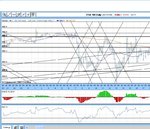fire away boy, the floors all yours
Hi TBT,
Given our recent communication via PM - there is quite a lot I could say in response to this comment, but that would be grossly unfair and unethical - so I won't!
😉
Re. comments made by you that supports my argument - here are a few:
Trend lines, to me, are drawn arbitrarily. I just use them as a sort of "comfort line".
Precisely my point! Where you draw them is different to where I draw them, to where Tom draws them etc., etc.
The rule that they must be drawn across the tops or bottom is, more or less, telling the market what to do. How can you expect that of a price?
Again, exactly my point. Of course we can't expect the market to behave as we would like it to or want it to!
When the price cuts the trend I look to see if a pattern is forming. If the pattern is continuous, I revert to a trend line, again, almost certainly, the momentum will have changed but if I keep to the right of it in a bear and to the left of it in a bull then I am OK- Whenever it crosses, it is a warning to pay attention to the trade, nothing more.
Agreed. You've described very well what trendlines are and what their purpose is. If price is above the trendline (in an uptrend), the market is bullish and if price has breached it, that's a sign that the current trend is faltering and the market may be about to change. Bu88er all to do with S&R!
Anyway, we've expressed our respective positions on the subject, so let's agree to disagree and draw a line under the matter. Subscribers to the thread can make up their own minds as to which of us is talking sense!
:cheesy:
Tim.
Tim
that was a post made some time back that describes the use of a trend line and Splits personal view of them at the time
I agree with that post
so we agree on trendlines
🙂
they are complete BS and the eye ball works just fine
The bit we disagree on is ~
"S&R are a separate entity and have nothing to do with trend"
imho they are connected and your post is a touch misleading, thats all.
not sure we do disagree, you just have not made it very clear Tim
regards ~
"Given our recent communication via PM - there is quite a lot I could say in response to this comment, but that would be grossly unfair and unethical - so I won't!"
sounds like a threat
my name is Andy
former T2w member ~ develbis, blackbear, pinkpig, bladerunner and SEMM
think thats the lot
🙂
I failed at intra day trading full time, I have full journal documents of every trade taken for a period of 1.5 years
I traded in profit for much of the time and was let down by my inability to cope with the sustained pressure which resulted in loss on account balance and an increase in unforced errors outside my method rules
The emotional errors were exaggerated by my lack of exact preperation and failure to anticipate what the market can do to you if you are not fully prepared
I have a fully developed method that is far better than me, my ability to trade it as per my own written instructions is effected to this day
I have become absolute risk averse and can only trade with very small stakes, even then the symptoms persist
by even bringing up a private pm up in a post you prove yourself to be grossly unfair and unethical
say what the F..ck you like mate
Fire away!
sure I will learn plenty from a guy who cannot define failure in the absolute sense and includes an unplanned FX trade (account funds held in dollars) to protect his ego and pride against an admission of loss
Andy

